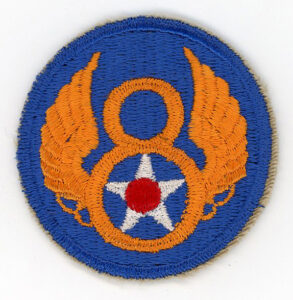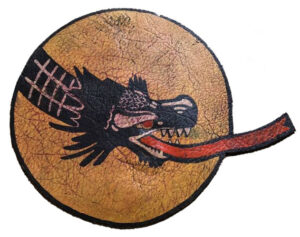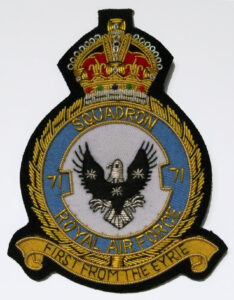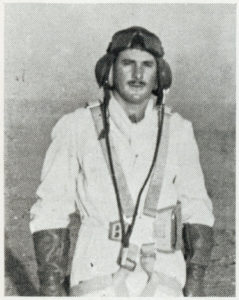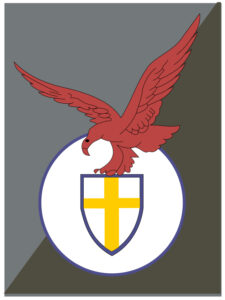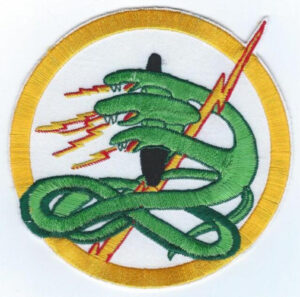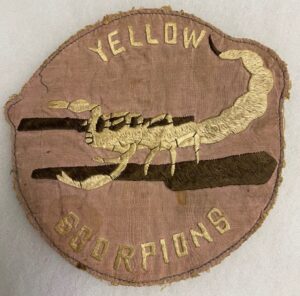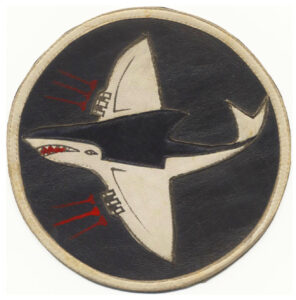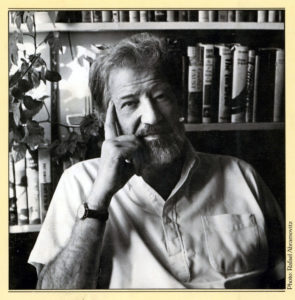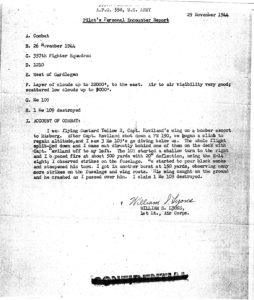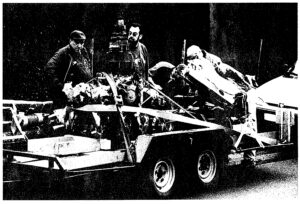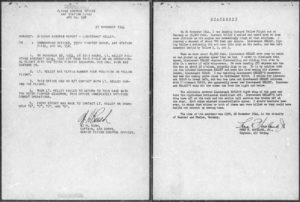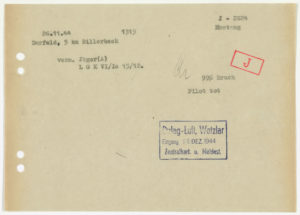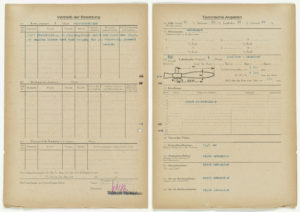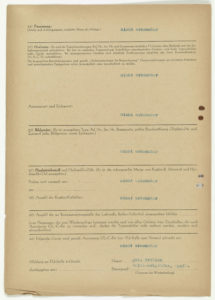Update – October 13, 2024
It’s now mid-October of 2024, and time once again to ( … drum roll … ) update this post. Reason being, I’ve recently come across three new videos about Bill Lyons and his experiences as a fighter pilot in the Second World War. The videos are: 1) Greg’s “P-51 Mustang Out-Turned by Fw 190 D-9? Yes, This Happened But…”, 2) Zack’s “Interview with Bill Lyons, WWII Fighter Pilot, 357th Fighter Squadron, 355th Fighter Group”, and 3) Jeff Simon’s “DOGFIGHT OVER GERMANY! WWII Hero Bill Lyons’ Untold Stories of Valor in the P-51 Mustang”. The videos themselves, and links to their creators’ YouTube channels are presented below.
Thus far I’ve only been able to view Greg’s video about P-51 versus FW-190D-9 combat, and of course, it’s fascinating and professionally done. Typical of Greg’s military aviation videos, he approaches topics from multiple vantage points: Those of technology (WW II technology, of course), engineering, aerodynamics, and the influence and implications of these three factors – whether for Allied or Axis aircraft – on military tactics.
I do look forward to viewing the other two videos.
* * * * *
Update – June 8, 2024
Covering the experiences of William S. Lyons as a P-51 fighter pilot in the 8th Air Force, this post – created in October of 2018 – has now been updated. It includes a half-hour-long interview of Bill from Flight Line Media’s YouTube channel, which can be viewed (just scroll down a little) under the heading “Video”. It’s a great interview; moving, sensitively carried out, and professionally done. Notably, Bill mentions his cousin Sylvan Feld, about whom you can find information at the “bottom” of this post, along with comments about Sylvan’s brother Monroe, who – as a member of the 450th Bomb Group – was shot down and taken prisoner during a mission to Hungary in 1945. Enjoy.
______________________________
 “God gives luck to somebody, but He needs such a lot of help from you!”
“God gives luck to somebody, but He needs such a lot of help from you!”
Lieutenant William Stanley Lyons, Steeple Morden, England, mid-August, 1944
__________________________________________________

“Tiger’s Revenge” – Aerial Victory at Magdeburg, Germany, February 9, 1945 (Digital art by Ronnie Olsthoorn; see more below.)
__________________________________________________
As recounted in the previous post, Sunday, November 26, 1944 is notable for the severe losses incurred by the Eighth Air Force – principally the 445th and 491st Bomb Groups. – during its mission to rail viaducts, marshaling yards and oil installations in western Germany.
However, there’s another aspect of that day which – though it would not assuage the grief of those families whose sons were lost in combat – provides, in a purely military context, a measure of recompense for that day’s losses: The significant number of aerial victories attained by fighter pilots of the Eighth Air Force in combat with the Luftwaffe.
According to USAF Historical Study No. 85 (USAF Credits for the Destruction of Enemy Aircraft, World War II) for November 26, Eighth Air Force fighter pilots were credited with 122 aerial victories, while elsewhere in Europe the 9th, 12th, and 15th Air Forces were credited with 13 enemy planes destroyed, and in the Southwest Pacific, 6 aerial victories were credited to fighter pilots of the 5th and 13th Air Forces.
Thus, on November 26, 1944, there were 141 confirmed aerial victories of USAAF fighter groups across all theatres of war. These are listed by Fighter Groups (and other units) below:
Europe
For the Eighth Air Force, total aerial victories by Group were:
78th Fighter Group – 9 victories (by 6 pilots)
339th Fighter Group – 28 victories (by 17 pilots; the highest scoring USAAF Fighter Group on November 26)
353rd Fighter Group – 3 victories (by 3 pilots)
355th Fighter Group – 21 victories (by 13 pilots)
356th Fighter Group – 22 victories (by 17 pilots)
359th Fighter Group – 1 victory
361st Fighter Group – 23 victories (by 18 pilots)
364th Fighter Group – 9 victories (by 7 pilots)
479th Fighter Group – 1 victory
And also:
2nd Air Division – 4 victories (by 2 pilots)
2nd Bombardment Division – 1 victory
Nine Air Force fighter units (one Group and one Fighter Squadron) were credited with the following aerial victories:
354th Fighter Group – 3 victories (by 1 pilot)
422nd Night Fighter Squadron – 1 victory (1 victory each credited to both pilot and radar operator)
In the Twelfth Air Force:
324th Fighter Group – 1 victory
And, in the Fifteenth Air Force:
14th Fighter Group – 8 victories (by 8 pilots)
Southwest Pacific
In the Fifth Air Force:
35th Fighter Group – 2 victories (by 2 pilots)
49th Fighter Group – 3 victories (by 3 pilots)
And, in the Thirteenth Air Force:
18th Fighter Group – 1 victory
______________________________
Among the Eighth Air Force fighter pilots who shot down German aircraft on November 26, 1944, was First Lieutenant William (“Bill”) Stanley Lyons (0-822214) of the 355th Fighter Group’s 357th Fighter Squadron, who later – on February 9, 1945 – shot down another German fighter for his second aerial victory, ultimately completing 63 combat missions over Europe. As reported in a letter published by the Brooklyn Eagle on December 28, 1944, under the heading “Over There”:
____________________
Here’s the emblem of the 357th Fighter Squadron. This image, of a painted-leather original jacket patch from WW II, was found at PicClick. (I edited the original photo for clarity.)
____________________
Diving from 15,000 feet to tree-top level, 1st Lt. William S. Lyons, of 6733 Ridge Boulevard, Mustang pilot, recently shot down a Messerschmitt 109 to tally his first victory over the Luftwaffe.
“Anybody who thinks the Luftwaffe is a thing of the past should have seen those 200 German fighters we tangled with,” said the lieutenant, recalling the aerial battle over Hanover, during which his group destroyed 22 enemy planes.
“There were about three big formations. When we first saw them they were preparing to attack the Liberators which our group was escorting. We intercepted the first wave and kept them off for a while, but there were so many Germans that they finally got to the bombers and hit them pretty hard.
“I managed to get behind one Me-109. I hit him in the fuselage a few times and smoke began streaming out of the plane. He tried to turn very tightly and I put another good burst into him. His wing-tip scraped the ground and he cart-wheeled and crashed.”
The 20-year-old flyer, a graduate of Brooklyn Technical High School, was employed in a defense plant before entering the service in 1942.
Akin to a significant number of American Jewish servicemen who participated in combat during the Second World War, Bill’s name never appeared in the 1947 publication American Jews in World War II. Regardless, he was awarded the Distinguished Flying Cross, Air Medal, and eight Oak Leaf Clusters.
Born on June 20, 1924, Bill’s parents were Edward Immanuel and Ethel (Goldstein) Lyons; his wartime residence was 6733 Ridge Boulevard, in Brooklyn.
With the passage of time, notably commencing in the early 2000s, Bill’s story has become easily; readily; immediately accessible.
Here are websites where you can learn more about his experiences, and, view images and artistic depictions of his “personal” P-51, Tiger’s Revenge…
Interviews
Audio
At Hyperscale, you can listen to Bill’s 10-minute account – recorded in 2006 – of his aerial victory during the Magdeburg mission of February 9, 1945.
Video(s)
Conducted on August 9, 2023, and uploaded to Flight Line Media on May 19, 2024, here is Flight Line Media’s interview of Bill, directed by Andrew Horton, videographer Caleb Stopa, and editor, Shawn Zhen.
* * * * * * * * * *
“The Jewish P-51 Fighter Pilot who Fought the Nazis | #7”
At: Flight Line Media, May 19, 2024.
* * * * *
“P-51 Mustang Out-Turned by Fw 190 D-9? Yes, This Happened But…”
At: Greg’s Airplanes and Automobiles, June 30, 2024.
* * * * *
“Interview with Bill Lyons, WWII Fighter Pilot, 357th Fighter Squadron, 355th Fighter Group”
At: “Oral Histories With Combat Veterans of America“, March 25, 2024.
* * * * *
“DOGFIGHT OVER GERMANY! WWII Hero Bill Lyons’ Untold Stories of Valor in the P-51 Mustang”
At: Social Flight, August 23, 2024.
* * * * * * * * * *
At the West Point Center for Oral History, you can view a two-hour interview of Bill as he recounts his experiences during the Second World War, in an interview entitled “A Mustang Over Europe”. Of particular interest is Bill’s presentation and description of two portraits taken during his service in the 357th Fighter Squadron (one of which forms the “header” image for this post), which can be viewed at HistoryNet.
The Texas Flying Legends Museum has a four-minute-long video of Bill’s flight in a two-Seat P-51D, piloted by TFLM pilot Mark Murphy, on September 7, 2013. The aircraft (actually P-51D 45-11586 / NL51PE) appears in the markings of aircraft 44-13551, Little Horse, of the 353rd Fighter Squadron, 354th Fighter Group, 9th Air Force.
Historical Accounts
LoHud (Long Island Hudson?- Part of the USA Today Network?) features a news item of August 31, 2014: “Honor Flight to fly WWII Vets to D.C. Memorials”, by Richard Liebson, about Bill’s 2014 visit to the National World War II Memorial, U.S. Marine Corps War (Iwo Jima) Memorial and Arlington National Cemetery. The visit was organized by Hudson Valley Honor Flight. The article includes eight photos, showing Bill, Bill and his wife Carol, and Frank Kimler of Hudson Valley Honor Flight.
As mentioned above, HistoryNet has Bill’s own well-written account of the November 26, 1944 Misburg mission (“Mustang Pilot’s Mission: A Day in the Life”) derived from a January 15, 2013 article in Aviation History Magazine.
The 12 O’Clock High Luftwaffe and Allied Air Forces Discussion Forum includes a discussion about Bill’s aerial Victory of February 9, 1945. A question: Could the German plane actually have been long-nose FW-190D (“Dora”) rather than an Me-109?
At the Library of Congress Veterans History Project, here’s the Biographical Entry for Bill Lyons.
Bill’s Mustang: P-51D-5-NT (Dallas built) 44-11342, “OS * F”, “Tiger’s Revenge”
Bill was assigned his own P-51 on November 29, 1944, after the completion of 129 hours of combat time. The plane bore the nicknames Tiger’s Revenge and Elaine on its port and starboard cowlings, respectively, the former being a double entendre: “Tiger” was Bill’s nickname within the 357th Fighter Squadron, while the phrase “Tiger’s Revenge” denoted vengeance on behalf of Bill’s cousin, Major Sylvan Feld, who was killed in France in the summer of 1944.
Tiger’s Revenge was lost on April 16, 1945, during a strafing attack on Eferding Airdrome, Austria, while being piloted by Captain Joseph E. Lake, of Delaware County, Indiana.
(Captain Lake was killed. According to his WW II Honoree Record (created by Martha A. Harris) his fate was only fully determined in 1949. He was buried at Elm Ridge Memorial Park, Muncie, Indiana, on May 25 of that year. Information about him can also be found at WW2 Aircraft.Net. The loss of Captain Lake and Tiger’s Revenge is an example – even in mid-1945 – of an ETO USAAF combat loss for which there is no Missing Aircrew Report.)
Nine beautifully rendered in-flight depictions of Tiger’s Revenge, seen from various vantage points, can be viewed at Sim Outhouse / SOH Combat Flight Center, under the heading “P-51D Tiger’s Revenge”. In light of copyright concerns, and, uncertainty about the artist’s identity (John Terrell?), rather than display the images “here”, you can view them directly at SIM-Outhouse.
A color profile of Tiger’s Revenge (by Nick King) can be viewed at Peter Randall’s Little Friends website, the profile being accompanied by two photographs of the actual airplane, all of which you can find at the Little Friends search page. Readily notable is the immaculate, shiny appearance of the fuselage, testimony to the conscientiousness of the fighter’s ground crew.
And, yet more…
Some years ago, I had the good fortune to meet and interview Bill “in person”. The result was a fascinating, enlightening, and moving conversation of about six hours duration, concerning his wartime, pre-war, and post-war experiences.
You can listen to excerpts from the interview – cumulatively somewhat over an hour long – below. The excerpts have been subdivided into three sections, with explanatory text and images below each section.
Akin to the interviews with Irving Newman, Lawrence Levinson, and Phil Goldstein, in my prior blog posts, the interview addresses sociological and psychological aspects of military service, and, philosophical issues, as well as (but of course) military technology and combat. Likewise, some parts of this interview cover topics perhaps not addressed elsewhere. (The intermittent vwhirrr – vwhirrr – vwhirrr – (and more vwhirrs!) – sound is from the micro-cassette recorder which was used to record the interview. (Remember audiotape?!))
Section I
00:00 – 11:08: Bill’s youth in Brooklyn, and the genealogical background of his family; his desire – from adolescence – to become a fighter pilot. His knowledge, during the 1930s, of events in Europe; the probability of war.
11:22 – 15:40: The relative degrees danger of different types of combat missions (specifically, strafing versus escort).
15:22 – 22:01: Variations in performance of different aircraft of the same type and model (for example, “P-51D versus P-51D”), and, the quality of aircraft maintenance. Preparation for combat missions.
Section II
00:10 – 02:08: Psychologically and sociologically adapting oneself to combat flying, in terms of the individual and the group.
02:24 – 03:17: The personalities of fighter pilots; Bill’s opinion of the 1986 movie Top Gun.
03:35 – 08:49: Given that he was flying combat missions over the Third Reich, Bill’s thoughts about the implications of being captured, and, identified as a Jew. The concept of courage – what is it? Human behavior in extreme situations. “God gives luck to somebody, but He needs such a lot of help from you!”
Commentary and Digression…
A number of Jewish fighter pilots became POWs of the Germans (and a few, of the Japanese) during the Second World War.
A few names are given below.
Royal Air Force – No. 65 Squadron
Waterman, Philip Fay, Flight Lieutenant, J/15023
Born in Saskatoon, Saskatchewan; 1919
Mr. M. Waterman (father), Leah and Matthew (sister and brother), 2912 West 31st Ave., Vancouver, British Columbia, Canada
Shot Down January 3, 1944
Aircraft: Spitfire IX, MA847
POW at Stalag Luft III; German POW # 1372
Canadian Jews in World War, Part II, p. 133
Royal Air Force Fighter Command Losses of the Second World War, Volume III, p. 11
This example of the No. 65 Squadron crest is from Air Force Collectables, where, dating from the mid-1980s, it’s described as, “RAF Patch 65 Squadron Royal Air Force Crest Patch Shadow For 229 OCU Operational Conversion Unit Tornado F 2 F 3 1986 RAF Chivenor Applique embroidered on twill cut edge 108mm by 77mm four and one quarter inches by three inches.“
____________________
Royal Air Force – No. 71 (Eagle) Squadron
Maranz, Nathaniel, Flight Lieutenant, 86617
Born New York, N.Y., January 12, 1919
Dr. Jacob M. and Mrs. Amelia (Schimmel) Maranz (parents), 102 East Fourth St., New York, N.Y.
Shot down by Me-109 of JG 2 or JG 26, on June 21, 1941. Gunshot wounds in both legs; burned foot. Picked up by German Air-Sea Rescue.
Aircraft: Hurricane II, Z3461
(Also, shot down and parachuted over England on April 6, 1941; Suffered burns.)
POW at Stalag Luft III, Sagan, Germany; German POW # 1372
Columbia University School of Pharmacy Graduate, Class of 1939
Changed surname to “Marans” by 1957
Died July 29, 2002, at Belvedre Tiburon, California
Jewish Post (Indianapolis) 6/27/41, 7/25/41
Jewish Chronicle 8/1/41, 8/8/41
Long Island Daily Press 9/2/41
New York Sun 3/19/41
New York Times 7/18/41, 9/2/41, 9/3/41
P.M. 8/20/41
Schenectady Gazette 6/24/41
The Knickerbocker News 9/2/41
The Times Record (Troy, N.Y.) 7/18/41
Utica Daily Press 7/18/41
We Will Remember Them, Volume I, p. 214
Behind The Wire, Record # 263
Royal Air Force Fighter Command Losses of the Second World War, Volume I, p. 121
This photo of Nathaniel Maranz is from the Columbia University Yearbook of 1939.
This example of the emblem of RAF No. 71 (Eagle) Squadron was found at the Etsy store TheMilitaryPlace. It’s a very nice contemporary reproduction of the insignia.
____________________
South African Air Force – No. 1 Squadron (“The Billy Boys”)
Wayburne, Ellis, Captain, 47508V
Born November 16, 1916
Mr. and Mrs. Meier Gerson and Sonia (Blank) Wayburne [Waigowsky] (parents)
Cyril, Gert, Harry, Issy, Laura, Lea, Mary, and Rose (brothers and sisters)
20 Beelaerts St., Troyeville, Johannesburg, Guateng, South Africa
Shot down September 23, 1944
Aircraft: Spitfire IX, MA313
POW at Stalag Luft II, Sagan, and Stalag IIIA (Luckenwalde)
Eagles Victorious, p. 307
85 Years of South African Air Force, pp. 300, 307
The Story of No. 1 Squadron S.A.A.F., Sometime Known as the Billy Boys, p. 424
Marcia Myerson (wife)…
…made Aliyah to Eretz Israel in 1970
This picture of Ellis Wayburne (possibly taken while he was a student pilot) is from The Billy Boys. It also appears in his autobiography.
Here’s a representative view of a No. 1 Squadron South African Air Force Spitfire, as such aircraft would have appeared in Italy from 1944 through the war’s end. According to military history enthusiast / modeler / author William S. Marshall, in SAAF WW2 Nose Art (which focuses on markings carried by Hurricanes and Spitfires of Number 1 Squadron) the plane is finished in, …”RAF Ocean Grey /RAF Dark Green with RAF Medium Sea Grey undersides in the typical day fighter scheme used in Italy during 1944/45.” This particular aircraft is Spitfire Mk VIII JF322, as flown by Lt. Hilton Ackerman. The illustration, by P.J. van Schalkwyk, is from Winston Brent’s 85 Years of South African Air Force. Unfortunately, I’ve no idea of the identification letter or nose art (if any?) of Ellis Wayburne’s MA313.
Here’s the emblem of Number 1 Squadron SAAF, as it appeared on the engine cowlings of the Squadron’s Spitfires. The example presented here appears in SAAF WW2 Nose Art.
____________________
United States Army Air Force
Korotkin, Louis, 2 Lt., 0-749567, Distinguished Flying Cross, Purple Heart, 10 combat missions
10th Air Force, 80th Fighter Group, 459th Fighter Squadron (The “Twin Tail Dragons”)
Born Brooklyn, New York, June 5, 1919
Mrs. Angelina J. (Sanicola) Korotkin (wife), 97-29 91st St., Ozone Park, N.Y.
Mr. Isidore Bronstein (father), 91-07 101st Ave., Ozone Park, N.Y.
Shot down February 3, 1944; Evaded until February 8, when captured by Japanese patrol; Liberated 4/28/45
Aircraft: P-38H, 42-66981; MACR 2089
POW at Burma #5; Moulmein & Rangoon Jail
Graduated Williams Field, Arizona, 6/22/43
Long Island Daily Press 5/28/45
The Leader-Observer 5/31/45
The Record (Richmond Hill, N.Y.) 5/31/45, 3/1/44, 5/28/45
American Jews in World War Two, p. 366
_____
Here’s a low-resolution photo of Louis Korotkin in Propwash – Class 43-F – Sequoia Field – Visalia, Calif., from Army Air Forces Collection. This is the only image of Louis Korotkin that seems to exist on (or, via) the Internet.
_____
Here’s the squadron insignia of the 459th Fighter Squadron, which – given that the unit was equipped with P-38s – quite appropriately depicts the twin engines and central “gondola” of the Lightning as lightning-shooting snakes.
____________________
Willner, Edward A., 2 Lt., 0-671824, Air Medal, Purple Heart
10th Air Force, 311th Fighter Group, 530th Fighter Squadron
Mrs. Lillian (Greenberg) Willner (wife), 2646 Tuxedo St., Detroit, Mi.
Mr. C.R. Willner (father) , Westwoods, Ca.
Shot down November 27, 1943
Aircraft: P-51A, 43-6265; MACR 1213
POW at Burma #5; Moulmein & Rangoon Jail
The Jewish News (Detroit) 6/29/45, 7/6/45
American Jews in World War Two – Not listed
Here are two versions of the squadron insignia of the 530th FS.
This image is via Military Aviation Artifacts…
…while this image is from the cover of the book 530th Fighter Squadron – 1942-?, the squadron’s wartime-printed history, once available (alas, no longer: it’s been purchased, but a few pages are still on display!) from Flying Tiger Antiques.
____________________
Wood, Henry Irving, 1 Lt., 0-789035, Air Medal, Purple Heart
14th Air Force, 23rd Fighter Group, 75th Fighter Squadron
Born 1918
Mrs. Josephine (Hughes) Wood (mother), 2217 Herschell St., Jacksonville, Fl.
Shot down October 1, 1943
Aircraft: P-40K, 42-46250; MACR 759
POW at Shanghai POW Camp, Kiangwan, China
Craig Field, Alabama, Class 42-D
Jacksonville Commentator 10/21/43, 11/5/43
American Jews in World War Two, p. 86
Lt. Wood’s portrait is from the United States National Archives collection: “Photographic Prints of Air Cadets and Officers, Air Crew, and Notables in the History of Aviation – NARA RG 18-PU”. (In this case, Box 102.)
This example of the 75th Fighter Squadron insignia is from Flying Tiger Antiques.
____________________
Back to the interview…!
09:06 – 09:41: Did Bill ever discuss the above topic – being a Jewish aviator, flying over Germany – with anyone else? (No.) Did he know any other Jewish airmen in the 357th Fighter Squadron? (Yes.) One: Lieutenant Jack H. Dressler.
09:38 – 18:27: An encounter with antisemitism (the comments of “Lieutenant X”).
Commentary and Digression…
The historical records of the 357th Fighter Squadron revealed that Bill’s memory of Lieutenant X’s surname – deleted for the purpose of this blog post – was dead-on accurate. The man passed away in the mid-1950s. In any event, the Latin expression: “Res ipsa loquitur,” – “The thing speaks for itself,” is as pertinent as it is sufficient.
As I listened to Bill “then”, and once again while creating this post, I was reminded of Len Giovannitti’s 1957 novel The Prisoners of Combine D, a novel about a group of American prisoners of war in Germany from late 1944 through the war’s end in May, 1945. Inspired and loosely based upon Giovannitti’s experiences as a POW in Stalag Luft III, a central plot element involves the identification and attempted segregation of Jewish POWs in the camp … which event actually transpired in Stalag Luft I and Stalag 9B (Bad Orb), but not Sagan. Jewish POWs were not segregated at the latter camp, probably due to a combination of the intervention and policies of the senior allied officers, and, the timing of the forced march of all POWs from that camp, which commenced on the evening of January 27, 1945.
The cover of Bantam Books’ 1959 paperback edition of the novel appears below. Though the cover artist is unknown and the art itself undramatic, albeit directly relevant to the story, this illustration is – ironically – vastly better than the uninspired, monochrome composition by the strangely over-rated Ben Shahn, which graces the dust jacket of the book’s (hardback) first edition.
 The novel’s central characters (Bendel, Fernandez, Kitchener, Lawton, Storch, and Zuckerman) represent individuals of a variety of social, and ethnic backgrounds, while in a literary sense, all are generally “three dimensional” in terms of representing distinct individuals with different personalities.
The novel’s central characters (Bendel, Fernandez, Kitchener, Lawton, Storch, and Zuckerman) represent individuals of a variety of social, and ethnic backgrounds, while in a literary sense, all are generally “three dimensional” in terms of representing distinct individuals with different personalities.
The novel pays absolutely no attention to aerial combat, and very little attention to pre-war events, life in the United States, postwar plans, or life – in “general” – elsewhere and elsewhen. In effect and intention, the novel’s entire “world” – in terms of both time, space, and thought – is confined to the immediacy of the POW camp, and, the psychological impact of being a prisoner of war.
Not evident – perhaps intentionally so, given the tenor of the 1950s? – from the blurb on the rear cover, the central character turns out to be “Hyman Zuckerman” (I would think refreshingly unrelated to Philip Roth’s “Nathan Zuckerman”!) who is almost certainly a fictional representation of Giovannitti himself.
As for his military service, Len Giovannitti (ASN 0-811621) was a navigator in the 742nd Bomb Squadron of the 455th Bomb Group, and was one of the seven survivors from B-24H 41-29261 – Gargantua – piloted by 1 Lt. Ralph D. Sensenbrenner, which was shot down during the 15th Air Force’s mission to Vienna on June 26, 1944, his 50th mission. The plane’s loss is covered in MACR 6404 and Luftgaukommando Report ME 1492.
The image below shows Giovannitti’s “Angaben über Gefangennahme von Feindlichen Luftwaffenangehörigen” (“Information about capture of enemy air force personnel”) form, from the Luftgaukommando Report.
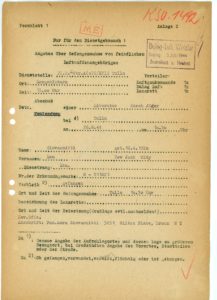 In Giovannitti’s semi-autobiographical novel, The Nature of the Beast (1977), the protagonist is named Dante Ebreo. The name is strikingly symbolic, seemingly derived from “Dante” – as in the name of the renowned poet “Durante degli Alighieri”, author of The Divine Comedy, combined with “Ebreo” – the Italian word for “Jew”. Within the book, Giovannitti devotes one chapter to his – or is it “Dante Ebreo’s”? – experiences during the Second World War. Here, he recounts his final mission in great detail (even naming his pilot “Sensebrenner” ), concluding with a few paragraphs which summarize the profound impact of his war experiences in general – and captivity in Germany, in particular – upon his life, within the overall arc of Dante Ebreo’s – or is it Len Giovannitt’s? – story.
In Giovannitti’s semi-autobiographical novel, The Nature of the Beast (1977), the protagonist is named Dante Ebreo. The name is strikingly symbolic, seemingly derived from “Dante” – as in the name of the renowned poet “Durante degli Alighieri”, author of The Divine Comedy, combined with “Ebreo” – the Italian word for “Jew”. Within the book, Giovannitti devotes one chapter to his – or is it “Dante Ebreo’s”? – experiences during the Second World War. Here, he recounts his final mission in great detail (even naming his pilot “Sensebrenner” ), concluding with a few paragraphs which summarize the profound impact of his war experiences in general – and captivity in Germany, in particular – upon his life, within the overall arc of Dante Ebreo’s – or is it Len Giovannitt’s? – story.
Early in the novel, in the context of the fate of the camp’s Jewish POWs, Zuckerman expresses the following thoughts to his friend, Edward Lawton:
Zuckerman: I used to think a pogrom might happen in New York
and I’d get killed.
And now it’s my yardstick, you might say.
Lawton: How do you mean?
Zuckerman: I measure people against it.
I say to myself, if a pogrom really did happen
and …(if) people like me were threatened with death,
what would he do, my friend?
Would he fight for me or would he turn away,
a little sick maybe, but turn away.
It’s not really fair, I guess,
because a pogrom would be after me and I’d have to fight,
but I want to know who’s with me and who’s against me
and who’s just going to watch and be sick.
Given Giovannitti’s literary skill, it would have been invaluable if he’d re-visited his wartime experiences in non-fiction format, as did David K. Westheimer, author of Song of the Young Sentry (and Von Ryan’s Express), in his 1992 book Sitting It Out – A World War II POW Memoir. Unfortunately for history, that book never came to be. As Len Giovannitti confided to me some years back, a little over three decades after the completion of Prisoners, he no longer had any desire to “re-visit” his Second World War experiences, whether as fiction or fact. Perhaps his novel – the writing of which spanned four years – was enough.
Alas. It would have been interesting…
Born in April of 1920, Len Giovannitti was a writer and producer / director of television documentaries. He died in March, 1992. Like Bill Lyons, his name never appeared in American Jews in World War II.
Perhaps more about Len Giovannitti in a future post. But in the meantime, here’s a portrait of Len Giovannitti from the jacket of his semi autobiographical novel, The Nature of the Beast. The image presumably dates from the mid-1970s, given that book’s 1997 publication date.
______________________________
And so, back to the interview with Bill Lyons…
Section III
00:06 – 0:37: What happened to Jack Dressler?
Commentary…
…as for “Dressler”, Bill’s memory was remarkably accurate:
“Dressler” was 2 Lt. Jacob (“Jack”) Harry Dressler (0-824608), from 81-21 20th Avenue, in New York. The son of Morris and Anna (Braunfeld) Dressler (parents), his siblings were Jack, Miriam, and Paul.
As recorded in the historical records of the 357th Fighter Squadron for March 15, 1945, “Lieutenant Dressler on this mission ran short of gas and was last seen heading toward the Russian lines. He wasn’t heard for two weeks and was given up as missing in action. Then on the 30th of March the report came in that he was safe and was on his way back to the squadron.” (See below.) The historical records of the 357th Fighter Squadron contain no information about his experiences in Russia, simply noting that he returned by April.
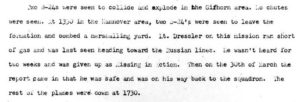 He was flying P-51D 44-14314 (OS * L), intriguingly nicknamed Sexless Stella / One More Time (what inspired that moniker?!). (This information is from Peter Randall’s Little Friends.) There is no MACR for this incident. The plane was one of at least eleven 8th and 15th Air Force P-51s that landed in the Soviet Union, or behind Soviet lines, between 1944 and 1945, based on data compiled by Martin Kyburz, of Swiss Mustangs.
He was flying P-51D 44-14314 (OS * L), intriguingly nicknamed Sexless Stella / One More Time (what inspired that moniker?!). (This information is from Peter Randall’s Little Friends.) There is no MACR for this incident. The plane was one of at least eleven 8th and 15th Air Force P-51s that landed in the Soviet Union, or behind Soviet lines, between 1944 and 1945, based on data compiled by Martin Kyburz, of Swiss Mustangs.
Jack Dressler’s name appears on page 299 of American Jews in World War II, with the notation that he received the Air Medal, likely indicating that he completed between 5 and 10 combat missions. Born in Brooklyn, New York, on April 25, 1923, he died on November 2, 2017. His portrait, from Legacy, appears below:

00:51 – 02:17: Bill’s attitude towards the Germans, as “people”, and, as opponents in aerial combat.
02:44 – 07:58: Bill’s interactions with British civilians. Impressions of Steeple Morden and Letchworth. Dating a German-Jewish refugee girl – “Elsa” – in Letchworth.
08:11 – 17:38: Shooting down an Me-109 over Magdeburg, Germany, on February 9, 1945.
Commentary…
Here’s the Encounter Report for Bill’s aerial victory:
 …and here is Ronnie Olsthoorn’s depiction of Bill’s victory, which appeared in 2007 at Hyperscale, which is accompanied by Bill’s account (audio) of this event.
…and here is Ronnie Olsthoorn’s depiction of Bill’s victory, which appeared in 2007 at Hyperscale, which is accompanied by Bill’s account (audio) of this event.
 Created in 2005, the original work was presented to Bill at the 355th Fighter Group reunion in October of 2005, with A-2 size signed prints (signed by Ronnie Olsthoorn and Bill) then being made available at Digital Aviation Art. The signed prints have since sold out, but Giclee (fine art digital inkjet prints) seem (?) to still be available through Mr. Olsthoorn’s site.
Created in 2005, the original work was presented to Bill at the 355th Fighter Group reunion in October of 2005, with A-2 size signed prints (signed by Ronnie Olsthoorn and Bill) then being made available at Digital Aviation Art. The signed prints have since sold out, but Giclee (fine art digital inkjet prints) seem (?) to still be available through Mr. Olsthoorn’s site.
Several qualities contribute to the striking nature of this artwork: The image is characterized by its unusual perspective – the action is viewed front the front of the aircraft, not the side; the complementary use of light (bright horizon) versus dark (shadows, earth tones, and darkened sky tones towards the top of the image); the degree of detail (details of the data block on the fuselage of the P-51 are visible); and the compositional relationship of the P-51 (foreground) and Me-109 (background).
“Moroney” is 1 Lt. Edward J. Moroney, Jr. (ASN 0-806496) who attained three confirmed victories while flying in the 357th Fighter Squadron (one on November 2, and two on November 26). He was from Highland Park, Il., and was killed in the crash of F-84E 50-1209 on June 8, 1951, one of eight F-84E Thunderjets that crashed near Richmond, Indiana, that day. He is buried at Saint Mary Catholic Cemetery, Lake County, Il. The news article below, from the Rome Daily Sentinel (New York) of June 11 (via Thomas M. Tryniski’s FultonHistory website) lists the pilots involved in the accident, as well as their addresses and next of kin:
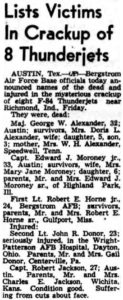
17:38 – 22:48: Shooting down an Me-109 on November 26, 1944.
Commentary…
Here is the encounter report for this aerial victory…
…and here’s a picture of Bill, taken shortly after his return from this mission. As described by Bill in The West Point Center for Oral History video (1:58:30 – 1:59:35), the picture was taken by Bill’s crew chief using the gun camera from Bill’s Mustang (behind), which had been temporarily removed from the fighter’s wing to capture the image.
 “Fred Haviland” is Capt. Fred R. Haviland, Jr., who attained six aerial victories in the 357th Fighter Squadron.
“Fred Haviland” is Capt. Fred R. Haviland, Jr., who attained six aerial victories in the 357th Fighter Squadron.
23:10 – 25:53: Encounter with an Me-262 on March 3, 1945.
Commentary and Digression…
Here’s Bill’s Encounter Report for this mission…
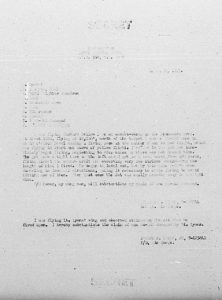 Since the (above) digital image – from microfilm – is extremely difficult to read, an image of a transcribed version of this Encounter Report appears below…
Since the (above) digital image – from microfilm – is extremely difficult to read, an image of a transcribed version of this Encounter Report appears below…
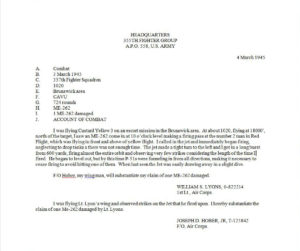 …while here is a (400 dpi) scan from Bill’s flight log, covering missions from March 2 through March 19, which mentions the encounter with the Me-262. “Escort to Magdeburg. – Fight with jets. – Damaged one Me-262. – Damn near had him. – Boresight off, fired with tanks.”
…while here is a (400 dpi) scan from Bill’s flight log, covering missions from March 2 through March 19, which mentions the encounter with the Me-262. “Escort to Magdeburg. – Fight with jets. – Damaged one Me-262. – Damn near had him. – Boresight off, fired with tanks.”
 While some visitors to this post will doubtless be immediately familiar with the Messerschmitt 262 – and thus need no introduction to the aircraft – for those unfamiliar with WW II military aviation, a depiction of the plane is displayed below, for representative purposes. Notably, this illustration does not depict the specific Me-262 which Bill pursued on March 3, the unit and markings of which are unknown. Rather, it’s simply a very good; quite evocative picture: the “box art” for Airfix’s 1/72 scale Me-262A-1A (kit A03088), and shows a Schwalbe of KG(J) 54 attacking B-17s of the 351st Bomb Squadron of the 100th Bomb Group on March 18, 1945.
While some visitors to this post will doubtless be immediately familiar with the Messerschmitt 262 – and thus need no introduction to the aircraft – for those unfamiliar with WW II military aviation, a depiction of the plane is displayed below, for representative purposes. Notably, this illustration does not depict the specific Me-262 which Bill pursued on March 3, the unit and markings of which are unknown. Rather, it’s simply a very good; quite evocative picture: the “box art” for Airfix’s 1/72 scale Me-262A-1A (kit A03088), and shows a Schwalbe of KG(J) 54 attacking B-17s of the 351st Bomb Squadron of the 100th Bomb Group on March 18, 1945.
 The B-17 on the right is 1 Lt. Rollie C. King’s 43-37521, (EP * K – Heavenly Daze / Skyway Chariot) not so coincidentally the subject of Airfix’s 1/72 kit A08017, the box art of which is shown below. The bomber indeed was shot down on March 18, 1945 by Me-262s (with the deaths of three crewmen) though the painting shows the B-17 being shot down by FW-190s. The loss of Heavenly Daze is described in radio operator S/Sgt. Archie Mathosian’s 1991 letter to 100th BG Association Historian Jim Brown.
The B-17 on the right is 1 Lt. Rollie C. King’s 43-37521, (EP * K – Heavenly Daze / Skyway Chariot) not so coincidentally the subject of Airfix’s 1/72 kit A08017, the box art of which is shown below. The bomber indeed was shot down on March 18, 1945 by Me-262s (with the deaths of three crewmen) though the painting shows the B-17 being shot down by FW-190s. The loss of Heavenly Daze is described in radio operator S/Sgt. Archie Mathosian’s 1991 letter to 100th BG Association Historian Jim Brown.
 25:45 – 26:35: Memories of two pilots who were lost on November 26, 1944: 1 Lt. Bernard R.J. Barab and 2 Lt. Charles W. Kelley, killed in a mid-air collision witnessed by Bill.
25:45 – 26:35: Memories of two pilots who were lost on November 26, 1944: 1 Lt. Bernard R.J. Barab and 2 Lt. Charles W. Kelley, killed in a mid-air collision witnessed by Bill.
Commentary…
Biographical information about Bernard R.J. Barab and Charles W. Kelley follows below:
1 Lt. Bernard R.J. Barab, 0-796643, Air Medal, 1 Oak Leaf Cluster, Purple Heart
Mr. and Mrs. Samuel and Mary (Curran) Barab (parents), Thelma and Eileen (sisters), 2 South Bartram Ave. / 927 Atlantic Ave. / 127 Ocean Ave., Atlantic City, N.J.
Mr. Richard L. Barab (cousin)
MACR 11079, P-51D 44-13574; No Luftgaukommando Report?
Name appeared in casualty list published on November 1, 1945
Ardennes American Cemetery, Neupre, Belgium – Plot C, Row 6, Grave 52
Bernard Barab’s name appeared in a Casualty List issued by the War Department on October 31, 1945. The New York Times published the list on November 1, limiting the names to servicemen from New York, New Jersey, and Connecticut. Barab’s name appearing under “New Jersey – European Area”.
 2 Lt. Charles W. Kelley, 0-826462 (presumably received Purple Heart; other awards unknown)
2 Lt. Charles W. Kelley, 0-826462 (presumably received Purple Heart; other awards unknown)
Born August 2, 1919
Probably from Hyattsville, Md.
Mrs. Helen Hawk (daughter) (Information from biographical profile at Registry of National WW II Memorial)
MACR 10886, P-51C 42-106910; Luftgaukommando Report J 2624
Mount Bethel United Methodist Church Cemetery, Crimora, Virginia
______________________________
The Tiger’s Cousin: Major Sylvan Feld
.ת.נ.צ.ב.ה.
Ironically, in light of the ready availability of information and photographs concerning the military service of William Lyons, there is relatively – far, if not vastly – less known about his cousin, the man who served as the inspiration for Bill’s military service: Major Sylvan “Sid” Feld.
Among American pilots who flew the famous Spitfire fighter plane while specifically serving in the United States Army Air Force, “Sid” Feld attained the highest number of kills (nine) against German aircraft.
As recounted by Bill in the West Point Center for Oral History video (from 14:00 – 15:00), along with Bill’s innate interest in aviation, his parallel inspiration to become a fighter pilot was his cousin Sylvan Feld, who was born in Woodhaven, Queens, on August 20, 1918.
Bill’s first cousin on his mother’s side, Sylvan’s family originated in Bayshore, Long Island, where Sylvan’s father Nathan worked as a driver for Bill’s grandfather, in the dairy business. Nathan subsequently worked in lumber and construction, where he and Bill’s father Immanuel became “more or less partners” until Immanuel decided to work at Wall Street. Nathan moved to Lynn, Massachusetts in mid-thirties or late thirties, where he opened a dairy.
Remembering Sylvan from his childhood in the (then) very rural area of Bayshore, Bill viewed himself as a “little kid” who Sylvan, along with Sylvan’s older brother “Herbie” (Monroe Herbert) and their older sister Evelyn, “sort of took care of me. Babysat for me.“
However, Bill didn’t actually see Sylvan after the age of six or seven. (1930 – 1931) “There was the one letter that he wrote me… He was just advising me that I’d really like to be a pilot. He said if you’re going to be in the service, then you’ve got to be an officer, and a pilot, because it’s a terrific life. The idea was that it was a good life, and a worthwhile one.”
Towards the end of Bill’s teens, while he was working at the Sperry Gyroscope, Sylvan was flying in North Africa. “I remember a letter from him in which he heard that I was interested in becoming a pilot. He encouraged me. He said there was one great job in the service, and since I was eventually going to go into the service, he just assumed that I would be a pilot.”
The photographic portraits below respectively show Sylvan as a Flight Cadet at Kelly Field, and, his graduation portrait from June of 1942. They are both found in the National Archives’ collection ” RG 18-PU: “Records of the Army Air Forces” – “Photographic Prints of Air Cadets and Officers, Air Crew, and Notables in the History of Aviation” “.

 Both Monroe and Sylvan would eventually serve in the Army Air Force. Fate was kind to neither, albeit thankfully Monroe did survive the war.
Both Monroe and Sylvan would eventually serve in the Army Air Force. Fate was kind to neither, albeit thankfully Monroe did survive the war.
Born on June 23, 1915, in New York, Monroe (“Monroe Herbert” or “Herbie”) enlisted in the Army Air Force in January, 1942, becoming a Sergeant and waist gunner in the 723rd Bomb Squadron of the 450th (Cottontails) Bomb Group. His aircraft, B-24L 44-50245 “Princess Pat”, piloted by 1 Lt. Murray G. Stowe, was struck by flak down on March 12, 1945, during a mission to the Florisdorf Marshalling Yards, in Austria, the plane’s 10 crewmen parachuting (all with good ‘chutes) went of Lente, Hungary. Of the bomber’s crewmen, 8 survived as prisoners of war. Monroe and Sgt. Lawrence Cilestio were beaten so severely by Hungarian soldiers that, upon being reunited with their fellow crewmen, they were unrecognizable.
Two other crewmen – navigator 2 Lt. Richard H. Van Huisen and gunner S/Sgt. William R. Ahlschlager – landed safely by parachute, but were never seen again. As of 2018, they remain missing.
Like his cousin William, Monroe’s name never appeared in American Jews in World War II.
Born in Woodhaven, New York, on August 20, 1918, Sylvan was commissioned as a Second Lieutenant at Kelly Field, San Antonio, Texas, on February 13, 1942. He was one of the original pilots of the 4th Fighter Squadron, 52nd Fighter Group, which was originally assigned to the 8th Air Force, and then transferred to North Africa to support the landings there in November of 1942. He attained his aerial victories (4 Me-109s, 3 FW-190s, and 2 Ju-88s) between March and June of 1943, after which he returned to the United States.
He was subsequently assigned to the Headquarters Squadron of the 373rd Fighter Group, 9th Air Force, where he served as Operations Officer. It was in this capacity that he was shot down, near Argentan, France, on August 13, 1944, while flying P-47D Thunderbolt 42-25966 (loss covered in MACR 8584).
The MACR includes only one statement about his loss: A report by 1 Lt. Virgil T. Bolin, Jr., stating, “On 13 August 1944, I was flying Gaysong Red 3 on a dive bombing strafing mission. I became lost from the first element on a strafing [pair? – run?] and joined Yellow 1 and 2. A short time later Major Feld called and told me to come North East of Argentan to join him. I was on my way from Laigle when he called and said he was on fire and was bailing out. I did not see the plane or his chute.”
Evading the Germans for a few days, Major Feld was eventually captured. (The details are unknown, and by now, probably will remain unknown.) Placed with a small group of other captured Allied personnel – aviators and ground troops; British and Canadians – these soldiers had the tragic misfortune to be caught in the midst of a raid by American bombers in the town of Bernay. Some of the captured servicemen were wounded, and with a sad and terrible irony – for it was his 26th birthday – Sylvan was severely wounded.
He died the next day at Petit-Quevilly, while the small group of prisoners were being taken to Maromme.
All this is covered in MACR 8584, which contains correspondence focusing on the search for information about his final fate. After September of 1944, the trail of information grew cold.
Sylvan remained missing for a decade and a half. But, in 1959, during the disinterment and identification of German war dead buried in France, as a step to eventual reinterment in German military cemeteries, German officials discovered an American dog-tag and flying clothing associated with the body of a man identified only as an “unknown German soldier”.
American authorities were notified, and by November of 1959, after investigation, the remains of the “German soldier” were determined to actually be those of Sylvan.
He is buried at the Ardennes American Cemetery, at Neupre, Belgium (Plot B, Row 33, Grave 58). His burial plot appears in the image below, which was provided by the American Battle Monuments Commission.
 …while this 2013 image is by FindAGrave contributor Doc Wilson.
…while this 2013 image is by FindAGrave contributor Doc Wilson.
 As for Thunderbolt 42-25966, it’s unknown if this was his personal aircraft, or, a Thunderbolt from one of the 373rd’s three squadrons (410th, 411th, or 412th) which he randomly chose to fly on August 13. Given the location and circumstances of its loss, it is not (and probably could not have been) covered by a Luftgaukommando Report, while it’s unknown if its exact crash location is noted in Sylvan’s IDPF (Individual Deceased Personnel File); I don’t have a copy of that document.
As for Thunderbolt 42-25966, it’s unknown if this was his personal aircraft, or, a Thunderbolt from one of the 373rd’s three squadrons (410th, 411th, or 412th) which he randomly chose to fly on August 13. Given the location and circumstances of its loss, it is not (and probably could not have been) covered by a Luftgaukommando Report, while it’s unknown if its exact crash location is noted in Sylvan’s IDPF (Individual Deceased Personnel File); I don’t have a copy of that document.
However, information about Sylvan’s P-47 is found in Daniel Carville’s FranceCrashes website, in the following statement:
Lieu-dit La Commune – Neuvy-au-Houlme (1,8 km SE) -10 km S de Falaise – (Fouilles réalisées)
Location at the town of Neuvy-au-Houlme (1.8 km southeast) -10 km south of Falaise – (Excavations completed)
(Curiously, in Major Feld’s last radio message, he stated that he was northeast of Argentan, while the location 1.8 km southeast of Neuv-au-Houlme is northwest of Argentan.)
Fouille en 1988 par l‘Ansa – Recup : moteur – train mitrailleuse Browninq cal 0,50 (SN 1016677) – localisation précise du crash non communiquée
Search in 1988 by ANSA [Association Normand du Souvenir Aérien (“Normandy Air Remembrance Association”)] – Retrieved: engine – 0.50 caliber Browning machine gun (Serial Number 1016677) – precise location of the crash not communicated
Based on the above information, the maps below – shown in order of increasing scale – show the probable location of 42-25966’s crash site.
This map is centered upon the Normandy Region of France. The Red Google location pointer indicates the location listed above – 1.8 km southeast of Neuvy-au-Houlme; not visible at this scale – which is south of Falaise, in the Calvados Department.
 A larger-scale view shows the location of Neuvy-au-Houlme (outlined in red).
A larger-scale view shows the location of Neuvy-au-Houlme (outlined in red).
 Moving in closer, the the probable crash site of Major Feld’s Thunderbolt is denoted by the red oval.
Moving in closer, the the probable crash site of Major Feld’s Thunderbolt is denoted by the red oval.
 This image is an air-photo view of the above map. The probable crash site appears to be located in farmland, denoted as above by a red oval.
This image is an air-photo view of the above map. The probable crash site appears to be located in farmland, denoted as above by a red oval.
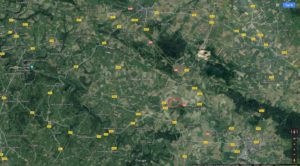 The image below shows the data plate that had been attached to the Thunderbolt’s engine. Information on the plate correlates to the engine type (R-2800-63) and serial number (42-56386) listed in MACR 8584. The photo originally appeared at Passion Militaria, in an image uploaded by “CED6250” on February 3, 2014, in a sub-forum entitled “le destin tragique du major Sylvan FELD, pilote de P47”) [“The Tragic Fate of Major Sylvan Feld, P-47 Pilot”.
The image below shows the data plate that had been attached to the Thunderbolt’s engine. Information on the plate correlates to the engine type (R-2800-63) and serial number (42-56386) listed in MACR 8584. The photo originally appeared at Passion Militaria, in an image uploaded by “CED6250” on February 3, 2014, in a sub-forum entitled “le destin tragique du major Sylvan FELD, pilote de P47”) [“The Tragic Fate of Major Sylvan Feld, P-47 Pilot”.
______________________________
Update, December 2022
At ANSA’s website, I recently discovered A.N.S.A.-MAG / Magazine de liaison de l’A.N.S.A. 39/45 for the first third of 1999 (No. 2 1er quadrimestre 1999), which carries information about the location and recovery of the wreckage of Major Feld’s Thunderbolt, specifically, “…a large piece of airframe, a complete landing gear and the engine in its entirety plus many miscellaneous parts.” The article includes two images of the plane’s Pratt & Whitney R-2800 Double Wasp engine. (Or to be specific, what’s left of the engine.) Unfortunately (oh, well…!) the exact geographic coordinates of the crash location of 42-25966 are not listed.
A transcript and English translation follow:
FOUILLES…
Le P 47 du Major Sylvan FELD
Le P 47 Thunderbolt du Major Sylvan FELD a été abattu le 13 Août 1944 lors de l’attaque de la poche de Falaise. Il appartenait au 373éme F.G.
Lors d’une attaque de bombardement et mitraillage sur des troupes allemandes au sol emprisonnées dans la poche de Falaise, après avoir effectué une passe de mitraillage , son avion prit feu. Aucun de ses co-équipiers ne le vit sauter. Il dût évacuer son avion en parachute et fut capturé en parfaite santé par les allemands.
Le Major FELD, qui était prisonnier des allemands, est mort le 21 Août à 1 heure du matin à Grand-Quevilly, aux chantiers de Normandie, des suites d’une blessure grave reçue à Bernay le 20 Août 1944 lors d’un bombardement américain. Lorsqu’il est mort, il était inconscient depuis la veille. Il attendait d’être chargé dans une ambulance allemande au bac de Croisset pour traverser la Seine en compagnie d’un canadien moins sérieusement blessé et d’un officier britannique.
Jean-Pierre NICLOT
Notre ami, Jean-Pierre NICLOT, a fait don, pour notre futur “Mémorial des combats aériens 39/45” d’un nombre impressionnant de pièces de grosse taille provenant de ce P 47 sorti de terre il y a environ 10 ans.
L’ANSA tient à le remercier vivement pour ce geste généreux qui nous va droit au coeur. Ces superbes pièces seront parfaitement mises en valeur dans le cadre d’un diorama de crash que nous avons prévu de présenter à l’intérieur du Mémorial.
Nous avons récupéré un morceau important de cellule, un train d’atterrissage complet ainsi que le moteur dans son intégralité plus de nombreuses pièces diverses.
Je laisse notre responsable de l’atelier, Roland BENARD, vous conter le rapatriement de ce matériel à notre entrepôt…. vu la taille et le poids des pièces, cela n’a pas été si simple que cela ….
Sylvain DEZELEE
Vérification de l’arrimage après quelques kilomètres de route.
1ère MISSION: Repérage du site
Au cours d’une réunion de Bureau, il fut décidé de répondre rapidement au souhait de notre ami Jean-Pierre NICLOT, membre de l’ANSA Yvelines qui souhaitait offrir de belles pièces aéronautiques pour garnir le futur Musée. C.A SIMONEAU se propose de prendre contact et le mercredi 21 Octobre, il nous emmena avec Michel DUTHEIL faire l’évaluation quantitative et réfléchir sur le mode opératoire pour manipuler des poids importants sans l’aide de moyens de levage mécanique, (l’emplacement de stockage du moteur ne permettant pas l’emploi d’engin de levage). Il nous fallait opérer avec le minimum de matériel et un maximum d’efficacité et de sécurité.
2ème MISSION: Traitement de l’objectif
C’est après avoir copieusement rempli le coffre de la 306 de quelques cales de bois, sangles, cordes, une barre à mine, des crics à crémaillère … et j’en passe, malgré un brouillard tenace et frisquet, qu’avec mon ami Michel DUTHEIL, nous nous sommes de nouveau rendus chez J-P NICLOT le mercredi 10 décembre 98. La principale difficulté concernait le moteur, il était dans une position et un endroit difficiles à manoeuvrer. A la vue de ce bijou, la tristesse et la froideur du climat furent bien vite oubliées. Un sentiment d’appréhension nous accompagna quelque temps au début de la manutention de cette pièce de plus de 800 kgs (probablement près de 900 kgs…). Rapidement, nos réflexes et savoir-faire, héritages de nos métiers antérieurs, nous permirent de faire pivoter, redresser et déplacer sur 5 métrés environ les 900 kg du moteur. Sans consulter nos montres, nos estomacs nous rappellèrent qu’il fallait “ravitailler”. Ce “stand-by” effectué dans un “mess” local, en compagnie de l’ami NICLOT et de son comparse, l’ami BERLIOZ, fût bien apprécié. La reprise des “opérations” fut consacrée à l’élévation de 40 cm du moteur sur son bâti afin de pouvoir reculer une remorque sous celui-ci et, avec le concours de quelques rouleaux …. il n’y aura … ka …pousser!
3ème MISSION: Retour à l’entrepôt
C’est avec une remorque porte-voiture prêtée par Philippe DUTHEIL et tractée par le 4 x 4 du Président, plus un fourgon et toujours accompagné d’un brouillard tenace qu’un “commando ébroïcien” a investi vers 9h le domicile de J-P NICLOT. Etant donné l’accès très difficle sur le lieu et l’étroitesse du portail, la mise en place de la remorque se fit manuellement, le manque de largeur de la rue empêchant une marche arrière aisée. L’aide de Nicolas VECCHI assisté de son père fut appréciée pour le “ya ka pousser le moteur sur la remorque”, ce qui ne fut pas une mince affaire. Ce fut ensuite le chargement d’une jambe de train (mon Dieu que c’était lourd, nous n’étions pas trop de cinq pour la lever!) et d’un bon morceau de structure (ça, c’était encore plus lourd, nous nous y sommes mis à sept pour le bouger… ), tout.ceci fut fermement arrimé. Quant au fourgon, il fut le bienvenu, car de nombreux accessoires y furent entassés, armement, pales d’hélice, cylindres du moteur, carburateur, pas variable …etc … La camionnette était pleine à mi-hauteur de vestiges.
L’arrimage du matériel ainsi que le chargement du fourgon furent termines pour midi. Après une halte au “mess local”, le retour s’effectua sans incident et c’est vers 16h environ que le déchargement se fit au dépôt avec le concours de notre hôte et de son chariot élévateur. Ce téléscopique fut le bienvenu poir vider aisément les presque deux tonnes de matériel posés sur la remorc-e if moteur, le train d’atterissage et le morceau de cellule).
Les mécanos de service vont se faire un plaisir de toiletter ces merveilles endormies. Il y a vraiment quelque chose de superbe à faire de ces belles pièces, surtout avec le moteur qui est presque complet.
Roland BENARD Responsable de l’entrepôt
****************************************
EXCAVATIONS…
Major Sylvan FELD’s P-47
The P 47 Thunderbolt of Major Sylvan FELD was shot down on August 13, 1944 during the attack on the Falaise pocket. It belonged to the 373rd F.G.
During a bombing and strafing attack on German ground troops trapped in the Falaise Pocket, after making a strafing pass, his aircraft caught fire. None of his teammates saw him jump. He had to evacuate his plane by parachute and was captured in perfect health by the Germans.
Major FELD, who was a prisoner of the Germans, died on August 21 at 1 a.m. in Grand-Quevilly, at the Normandy shipyards, following a serious injury received at Bernay on August 20, 1944 during an American bombardment. When he died, he had been unconscious since the day before. He was waiting to be loaded into a German ambulance at the Croisset ferry to cross the Seine in the company of a less seriously injured Canadian and a British officer.
Jean-Pierre NICLOT
Our friend, Jean-Pierre NICLOT, donated, for our future “39/45 Air Combat Memorial”, an impressive number of large pieces from this P 47 which came out of the ground about 10 years ago.
ANSA would like to thank him warmly for this generous gesture which goes straight to our hearts. These stunning pieces will be showcased perfectly as part of a crash diorama that we are planning to display inside the Memorial. We recovered a large piece of airframe, a complete landing gear and the engine in its entirety plus many miscellaneous parts.
I let our workshop manager, Roland BENARD, tell you about the repatriation of this material to our warehouse …. given the size and weight of the parts, it was not that simple…
Sylvain DEZELEE
Checking the stowage after a few kilometers on the road.
1st MISSION: Site scouting
During a Board meeting, it was decided to respond quickly to the wish of our friend Jean-Pierre NICLOT, member of ANSA Yvelines who wanted to offer beautiful aeronautical parts to furnish the future Museum. C.A SIMONEAU proposes to make contact and on Wednesday, October 21, he took us with Michel DUTHEIL to do the quantitative evaluation and to reflect on the operating mode for handling heavy weights without the aid of mechanical lifting means, (the location engine storage that does not allow the use of lifting gear). We had to operate with a minimum of equipment and maximum efficiency and safety.
2nd MISSION: Treatment of the objective
It was after copiously filling the trunk of the 306 with a few wooden wedges, straps, ropes, a crowbar, rack jacks… and so on, despite a tenacious and chilly fog, that with my friend Michel DUTHEIL, we went again to J-P NICLOT on Wednesday December 10, 98. The main difficulty concerned the engine, it was in a difficult position and place to maneuver. At the sight of this jewel, the sadness and the coldness of the climate were quickly forgotten. A feeling of apprehension accompanied us for some time at the beginning of the handling of this piece of more than 800 kgs (probably nearly 900 kgs…). Quickly, our reflexes and know-how, inherited from our previous trades, enabled us to rotate, straighten and move the 900 kg of the engine over approximately 5 meters. Without consulting our watches, our stomachs reminded us that we had to “refuel”. This “stand-by” carried out in a local “mess”, in the company of friend NICLOT and his sidekick, friend BERLIOZ, was well appreciated. The resumption of “operations” was devoted to the elevation of 40 cm of the engine on its frame in order to be able to move a trailer under it and, with the help of a few rollers …. there will be … ka …push!
3rd MISSION: Return to the warehouse
It was with a car carrier loaned by Philippe DUTHEIL and towed by the President’s 4 x 4, plus a van and always accompanied by a stubborn fog that an “Ebroïcien commando” took over the home of J-P NICLOT around 9 a.m. Given the very difficult access to the site and the narrowness of the gate, the installation of the trailer was done manually, the lack of width of the street preventing easy reversing. The help of Nicolas VECCHI assisted by his father was appreciated for the “ya ka pushing the engine on the trailer”, which was not an easy task. It was then the loading of a train leg (my God it was heavy, there were not too many of us to lift it!) and a good piece of structure (that was even heavier, there were seven of us to move it…), everything was firmly secured. As for the van, it was welcome, because many accessories were piled up there, armament, propeller blades, engine cylinders, carburettor, variable pitch … etc … The van was full halfway up with remains.
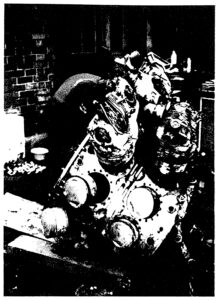 The stowage of the equipment as well as the loading of the van were finished by noon. After a stop at the “local mess”, the return was made without incident and it was around 4 p.m. that the unloading took place at the depot with the help of our host and his forklift. This telescopic was welcome to easily empty the almost two tons of material placed on the trailer if engine, the landing gear and the piece of cell).
The stowage of the equipment as well as the loading of the van were finished by noon. After a stop at the “local mess”, the return was made without incident and it was around 4 p.m. that the unloading took place at the depot with the help of our host and his forklift. This telescopic was welcome to easily empty the almost two tons of material placed on the trailer if engine, the landing gear and the piece of cell).
The service mechanics will be happy to groom these sleeping wonders. There really is something wonderful to be done with these beautiful pieces, especially with the engine which is almost complete.
Roland BENARD Warehouse Manager
______________________________
Compared to other WW II USAAF fighter groups, photographic coverage of the 373rd Fighter Group seems to be scanty. However, ironically, there are two excellent photographs of the specific P-47 (“Gaysong Red Three”, a.k.a. R3 * G) flown by Lt. Bolin when he received Major Feld’s last radio call.
One of these pictures appears in Kent Rust’s The 9th Air Force in World War II, where it’s listed as an official Army Air Force photo – though it doesn’t seem to be available via Fold3.com. The plane is seen flying near Mont St. Michel, France. It’s now a Getty Image, captioned as “Republic P-47D Thunderbolt (42-25845 R3-G) of 410th Fighter Squadron USAAF in flight near Mont St Michael, Normandy, 26 August 1944. (Photo by Charles E. Brown / Royal Air Force Museum / Getty Images)”.
 The other image of R3 * G is available at the American Air Museum in England, where it’s captioned, “A P-47 Thunderbolt (R3-G, serial number 42-25845) of the 373rd Fighter Group in flight. Image stamped on reverse: ‘Charles E Brown.’ [stamp], ‘Passed for publication 7 Sep 1944.’ [stamp] and ‘356662.’ [Censor no.] Printed caption on reverse: ‘P-47 Thunderbolt flying across open country.’” This picture has been scanned at an extremely high resolution, and zooming in on the photo reveals that the pilot is looking “up” through the canopy towards the photographer.
The other image of R3 * G is available at the American Air Museum in England, where it’s captioned, “A P-47 Thunderbolt (R3-G, serial number 42-25845) of the 373rd Fighter Group in flight. Image stamped on reverse: ‘Charles E Brown.’ [stamp], ‘Passed for publication 7 Sep 1944.’ [stamp] and ‘356662.’ [Censor no.] Printed caption on reverse: ‘P-47 Thunderbolt flying across open country.’” This picture has been scanned at an extremely high resolution, and zooming in on the photo reveals that the pilot is looking “up” through the canopy towards the photographer.
 Unlike his brother Monroe and cousin Bill, Sylvan’s name does appear in American Jews in World War II: on page 157. There, his military awards are listed as the Silver Star, Distinguished Flying Cross, Air Medal, 21 Oak Leaf Clusters (suggesting the completion of between 105 and 115 combat missions), and the Purple Heart.
Unlike his brother Monroe and cousin Bill, Sylvan’s name does appear in American Jews in World War II: on page 157. There, his military awards are listed as the Silver Star, Distinguished Flying Cross, Air Medal, 21 Oak Leaf Clusters (suggesting the completion of between 105 and 115 combat missions), and the Purple Heart.
During and after the Second World War, news items about Sylvan Feld appeared in the following publications:
Chicago Jewish Chronicle – 8/13/43
The American Hebrew – 8/13/43
Lynn [Massachusetts] Daily Item – 9/2/43, 11/15/44, 5/20/60
______________________________
The image below, by Chris Davey, is a profile of Sylvan Feld’s Sylvan’s personal Spitfire Vc (ES276, WD * D), which appears in Andrew Thomas’ American Spitfire Aces of World War 2. Notable is the absence of any distinctive personal markings, except for Feld’s name and victory symbols.
 The aircraft’s markings and camouflage are seen in the image below (artwork by Wojciech Rynkowski?) from the Montex company’s (Wroclaw, Poland) “Masks, decals & markings for Spitfire Mk Vb by Airfix – Product Number K48271 (decals and camouflage information for Spitfires EN794 and ES276)”.
The aircraft’s markings and camouflage are seen in the image below (artwork by Wojciech Rynkowski?) from the Montex company’s (Wroclaw, Poland) “Masks, decals & markings for Spitfire Mk Vb by Airfix – Product Number K48271 (decals and camouflage information for Spitfires EN794 and ES276)”.
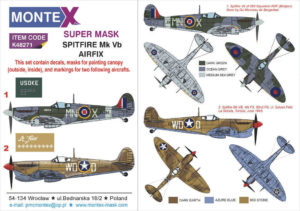 The British Eagle Strike Productions company also produced (in 2006) a decal set covering Major Feld’s Spitfire, and, three other USAAF MTO Spitfires, images of which also illustrate the markings and camouflage of USAAF MTO Spitfires. These decals are available from the Valka Company, located in the village of Osek nad Bečvou in the Czech Republic.
The British Eagle Strike Productions company also produced (in 2006) a decal set covering Major Feld’s Spitfire, and, three other USAAF MTO Spitfires, images of which also illustrate the markings and camouflage of USAAF MTO Spitfires. These decals are available from the Valka Company, located in the village of Osek nad Bečvou in the Czech Republic.
 I do possess more (but not really that much more) information about Major Sylvan Feld, but the above covers the essentials of his story, so far as those essentials can be known. Alas, a telephone inquiry to Monroe in the 1990s elicited a firm unwillingness – albeit, it must be stated, an unwillingness respectful and polite – to discuss either his brother’s life or his own military experiences.
I do possess more (but not really that much more) information about Major Sylvan Feld, but the above covers the essentials of his story, so far as those essentials can be known. Alas, a telephone inquiry to Monroe in the 1990s elicited a firm unwillingness – albeit, it must be stated, an unwillingness respectful and polite – to discuss either his brother’s life or his own military experiences.
Monroe died in Englewood, Florida, on June 11, 2007, and his sister Evelyn probably passed away in March of 1984.
______________________________
Ironically, more information seems to be available (at that, what little there really is!) about Major Feld’s aircraft; about Major Feld as a military pilot, than about Sylvan Feld as a son, brother, cousin, comrade, and friend. The final disposition of the correspondence (personal and official), documents, photographs, and memorabilia that he likely accumulated through his three years of military service – assuming that this material has even survived – is unknown. And, with the passing of his parents, sister, and brother, and members of their generations, recollections of him “as a person” have passed into history – and therefore beyond memory – as well.
Still, a memory partial, fragmentary, and indirect – for all men, both great and small – are in time remembered incompletely – is better than no memory whatsoever.
May this blog post perpetuate his memory, as best it can.
References
Books
Brent, Winston, 85 Years of South African Air Force – 1920-2005 (African Aviation Series No. 13), Freeworld Publications xx, Nelspruit, South Africa, 2005
Dublin, Louis I., and Kohs, Samuel C., American Jews in World War II – The Story of 550,000 Fighters for Freedom – Compiled by the Bureau of War Records of the National Jewish Welfare Board, The Dial Press, New York, N.Y., 1947
Franks, Norman L.R., Royal Air Force Fighter Command Losses of the Second World War, Volume I – Operational Losses: Aircraft and Crews 1939-1941, Midland Publishing, Ltd., Leicester, Great Britain, 1997
Steinberg, Lucien, “The Participation of Jews in the Allied Armies”, Jewish Resistance During the Holocaust, Proceedings of the Conference on manifestations of Jewish Resistance, Yad Vashem, Jerusalem, Israel, 1971, pp. 379-392
Franks, Norman L.R., Royal Air Force Fighter Command Losses of the Second World War, Volume III – Operational Losses: Aircraft and Crews 1944-1945 (Incorporating Air Defence Great Britain and 2nd TAF), Midland Publishing, Ltd., Leicester, Great Britain, 1997
Giovannitti, Len, The Prisoners of Combine D, Bantam Books, New York, N.Y., October, 1957 (Paperback edition January, 1959)
Holmes, Tony, Star-Spangled Spitfires, Pen & Sword Aviaton, Barnsley, South Yorkshire, England, 2017. (NOOK Book (eBook)), available from Barnes & Noble
Ivie, Tom, and Pudwig, Paul, Spitfires & Yellow Tail Mustangs: The U.S. 52nd Fighter Group in WWII, Stackpole Books, Mechanicsburg, Pennsylvania, 2013
Martin, Henry J., and Orpen, Neil D., Eagles Victorious: The operations of the South African Forces over the Mediterranean and Europe, in Italy, the Balkans and the Aegean, and from Gibraltar and West Africa, Purnell, Cape Town, South Africa, 1977
Morris, Henry, Edited by Gerald Smith, We Will Remember Them – A Record of the Jews Who Died in the Armed Forces of the Crown 1939 – 1945, Brassey’s, United Kingdom, London, 1989
Rust, Kenn C., The 9th Air Force in World War II, Aero Publishers, Inc., Fallbrook, Ca., 1970
Thomas, Andrew, American Spitfire Aces of World War 2, Osprey Publishing, New York, N.Y., 2007
Vee, Roger, The Story of No. 1 Squadron S.A.A.F., Sometime Known as the Billy Boys, Mercantile Atlas, Cape Town, South Africa, 1952
Wayburne, Ellis, Where There’s a Will, There’s a Way (…And Where There’s a Way, There’s a Wayburne), Israel, 1995 (privately printed)
Wright, Arnold A., Behind The Wire: Stalag Luft III – South Compound, Arnold A. Wright, Printed in Benton, Ar., 1993 (privately printed)
Canadian Jews in World War II – Part II: Casualties, Canadian Jewish Congress, Montreal, Quebec, Canada, 1947
USAF Credits for the Destruction of Enemy Aircraft, World War II, Albert F. Simpson Historical Research Center, Air University, Office of Air Force History, Headquarters, USAF, 1978.
Miscellaneous
357th Fighter Squadron Historical Records – AFHRA Microfilm Roll AO784 (“SQ-FI-357-Hi – SQ-FI-358 Hi”)
P-47 Thunderbolt serial number list (Wikipedia)
P-51 Mustang serial number list (via Joseph F. Baugher’s “USAF USASC-USAAS-USAAC-USAAF-USAF Military Aircraft Serial Numbers–1908 to Present” website)
10/25/18 – 3,962 / 6/8/24 – 4,034

